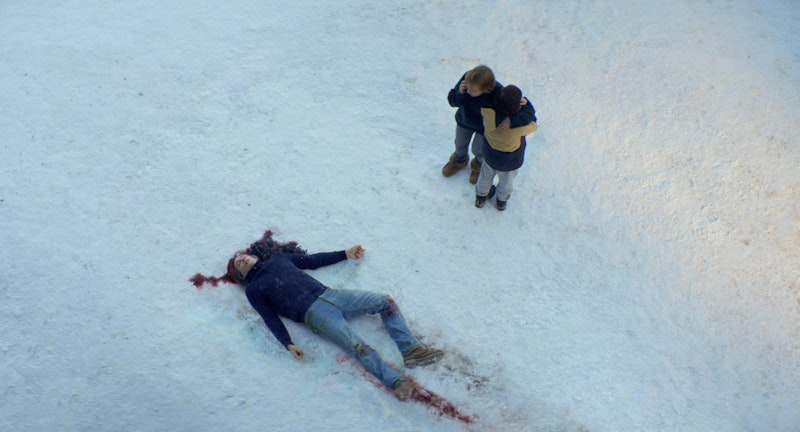Compared to Cannes 2019, 2021, and 2022, the buzz—at least here in the States—was considerably more muted this year. 2019 was one of those golden years that comes along once a cinematic generation (2004, 1999, 1972, 1959, 1939), and there was embarrassment of riches. Once Upon a Time in Hollywood should’ve won over Parasite, ditto for the Oscars, but Bong Joon-ho’s class battle genre grab bag was a worthy winner. Since the festival was cancelled due to the coronavirus pandemic in 2020, the following two years were triumphs simply for occurring, at least to me. I liked Titane, was bitterly disappointed by Triangle of Sadness, and in the end it didn’t matter because “movies were back.” The fact that Cannes, along with all the other major festivals were still around after 2020, was news enough.
But it still didn’t feel like this year’s festival got much attention over here. The announcement of the Palme d’Or, typically something certain people count down to, went with a whimper, or rather a whiff: an audience video of Jane Fonda announcing Justine Triet’s Anatomy of the Fall as the winner, Triet walking on stage and neglecting to pick up her certificate, walking past Fonda, and Fonda chucking the certificate at Triet’s head and walking off stage (Triet didn’t appear to notice). Since then, all I’ve heard about the film was a pan from Richard Brody, which I didn’t read until right after I saw the film on Monday night in Baltimore.
As often as I’ve criticized him, a good Brody piece is worth a dozen by almost anyone else. Coming out of Anatomy of a Fall, I was satisfied and surprised that its 152 minute runtime zipped by so quickly. The film is gorgeous, one of the best-looking digital productions I’ve seen recently, and it’s thrilling to see Sandra Hüller (star of 2016’s Toni Erdmann) grace American eyeballs after a seven-year absence. That was a much better film, but certainly more obscure, and it’s in Anatomy of a Fall that Hüller is able to demonstrate her abilities to a wider, English-speaking audience (just over half of Anatomy of a Fall is in French, the other half in English, with constant switching). She’s a much more compelling and exciting actress than Vicky Kreips, for example, who also dipped from view for a few years after Phantom Thread before reemerging with Old and Bergman Island.
Hüller plays a writer married to Samuel Theis, another writer; their blind son is played by Milo Macahdo-Graner. The film begins with alternating closeups of Hüller and a journalist played by Camille Rutherford: she’s being interviewed, all while an unseen Theis blasts an instrumental version of 50 Cent’s “P.I.M.P.” from upstairs, rendering the interview impossible. Cut to Macado-Graner walking his dog and coming back home to find his dad dead in the snow. It looks like a fall, and while the son sobs, the new widow phones the police, a bit more stable than her son. The investigation begins. The film opens, before any of the production company bumpers, with a brief white on black card reading “didshedoit.com."
Brody’s critique clarified my mixed feelings about the movie; I was satisfied, but not fulfilled. Anatomy of a Fall isn’t a challenging movie, nor is it a typical Palme d’Or winner: this is a gripping courtroom drama that enthralls you for two and a half hours and leaves you with nothing to take home. Despite ending ambiguously, with an acquittal for Hüller but no clear sense of the truth, the film isn’t nearly as eerie or evocative as Tár, another film that hinged on the interiority of a successful female artist. Triet’s film is, as Brody writes, “prestige cinema,” following all the conventions and morays of “prestige television.” He’s dead on: Anatomy of a Fall is gripping because it’s full of plot, twists and turns, and abundant exposition—in a word, television.
He’s also correct that mediocre movies held up as great cinema art is as great a risk to the medium as the Marvel Cinematic Universe. I don’t agree, for Anatomy of a Fall is precisely the kind of gateway movie that the cinematically-inclined teenager he evokes would respond to—I would’ve if I saw it at 11, 12, or 13. It has a slick style, with many evocative zooms that recall cable news cameras in their awkwardness and speed (I don’t agree with Brody that the film is shot “plainly;” it has some of the most interesting zooms since Sean Baker’s Red Rocket two years ago). And it’s not at all far from Succession, although I’m loathe to admit that Jesse Armstrong’s four-season television show has stuck with me in a way that very few shows do and most movies do by nature. Anatomy of a Fall is disappointing for that reason, a film that’s all empty calories, well-made and acted and a wonderful way to spend an evening, but the Palme d’Or? Really? I wasn’t a fan of Wes Anderson’s Asteroid City, but that’s a piece of cinema art, and one that’s just as much of a gateway for starry-eyed kids, if not more so.
But Anderson’s a known figure in the United States, and his aesthetic is even more familiar to the most casual moviegoer. Per Brody’s point, Anatomy of a Fall is a functional and entertaining film, but not something that belongs anywhere near the summit of cinema. It’s an important distinction to make now, when the medium is more imperiled than ever. As I watched Anatomy of a Fall, the film that kept coming to mind was last year’s She Said. Besides Hüller’s vague resemblance to Carey Mulligan, both of these films are full of information and little else. She Said was a fine journalist procedural, and Anatomy of a Fall is the same: just fine. The Palme d’Or?
—Follow Nicky Smith on Twitter: @nickyotissmith

